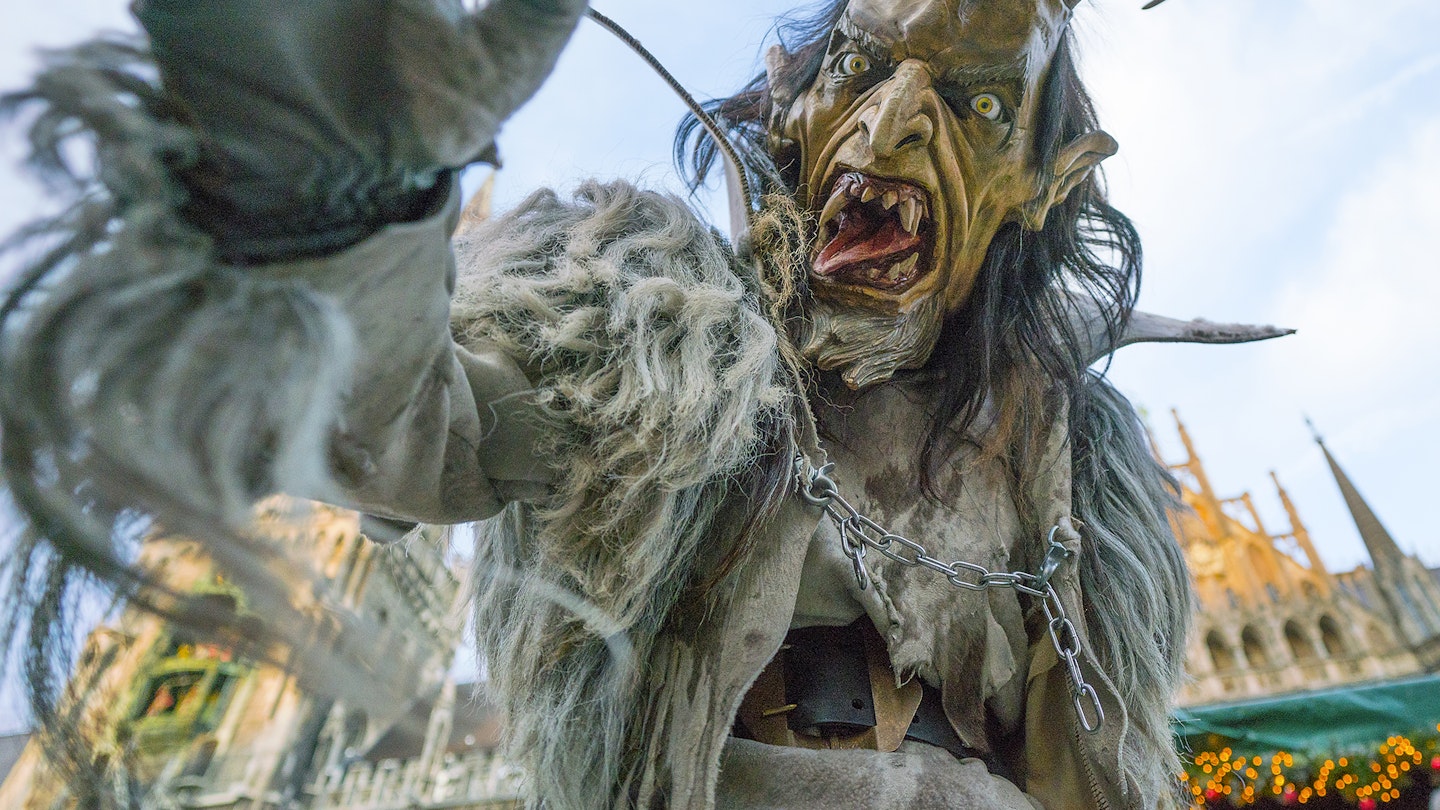Krampus: The Christmas Demon
The Krampus parade may have been canceled this year, but let’s take a look back at a trip to Munich for the country’s most unique holiday celebrations.
I’m basking in the holiday scene: happy Münchners sip hot glühwein around crackling firepits, and shoppers pause at Christkindlmarkt stalls selling tiered Christmas pyramids (Weihnachtspyramides) and hand-carved Nativity sets.
Suddenly, a cacophony of clanking overpowers the holiday tunes. Heads turn and people point, and I feel a heavy hand ruffle my hair. Turning around I’m face-to-grotesque-face with a forked tongue sticking out of a fanged mouth and curling ram’s horns jutting from its demonic forehead. Today in Munich, this frightening sight is as much a part of Christmas as Saint Nicholas. Krampus is in town, and today is his day.

The Krampus Run
Krampus is a Christmas demon that dates back centuries throughout the South Tyrol/Alpine region of Europe from southern Germany, Austria, and northern Italy into Croatia, Hungary, the Czech Republic, Bulgaria, and Slovenia. Krampus works in conjunction with Saint Nicholas, playing the bad cop to his good.
Whereas Saint Nicholas rewards good children with presents left in shoes and stockings, Krampus beats bad children with birch sticks and carries away the worst offenders in a woven basket he wears on his back. In this region, the Feast of Saint Nicholas is celebrated on December 6, and that night, children put out shoes to be filled with toys. However, the night of December 5 belongs to Krampus.
I’m in Munich to see its Krampuslauf (Krampus run), a parade of Krampus groups from all over Europe. More than 300 people dressed in Krampus outfits parade through the Marienplatz to the thrill of thousands of spectators. Munich typically sees its large Krampuslauf on the Sunday after December 6. Groups from across Europe travel to Munich for a march through the Marienplatz, much to the delight and mock horror of onlookers.

Older kids receive high-fives and fist bumps from the Krampuses, and uncertain young children quickly warm to these grotesque-yet-friendly beings, encouraged by their parents. In years past, spectators could expect to be bruised from a whack of a Krampus’ birch bundle called a ruten, and it is worth noting that today some Alpine communities are still known for having more aggressive Krampuslaufs.
However, during the events in Munich, the Krampuses appear more interested in causing smiles than welts. They comically hit each other with their bundles, pose for selfies, and swipe hats from spectators, returning them after placing them on a horn.
Tales and drawings of Krampus terrifying children date back to the 1600s in Germany, and greeting cards known as Krampuskarten were popular throughout the 1800s with the phrase Gruß vom Krampus (Greetings from the Krampus).

Origins of Krampus
Vestiges of Krampus exist in American culture as well, brought over by German immigrants in the 1800s and early 1900s. The coal left in the stockings of naughty children by Santa Claus was originally the doing of Krampus. Today, Santa Claus keeps a list, but in the past, Krampus was solely responsible for dealing with the naughty.
Krampus comes from the German word for claw, krampen. His image varies from region to region, but common features include goat-like legs, a shaggy body, clawed hands, two long horns, and a long tongue sticking out from a mouthful of fangs. In some Alpine villages like Munich, he appears on December 5, the day before the Feast of Saint Nicholas. In other cases, he accompanies Saint Nicholas to address any misbehaving children.
It’s believed Krampus evolved from beings called perchten, similarly scary creatures that possess multiple horns as opposed to Krampus’ two. Perchten date back to pagan times, designed to scare away the spirits of winter and herald spring.
As Christianity spread through this region, pagan traditions morphed into Christmas customs. Consequently, as Christmas became more commercialized, traditions that were less approachable waned. The Christmas tree remained, while Krampus slipped into the shadows.

Revival of Krampus
While Krampus clung on in the Alpine region, it was in the early 2000s when a concerted effort to keep the Krampus tradition alive took route in Europe. The rediscovery of this ancient cultural tradition inspired new generations to dust off Krampus masks kept in families or skillfully carve their own designs. Now, children, men, and women partake in Krampuslaufs all across Europe.
Their outfits often include real animal hair, horns, thick leather belts, and enormous cowbells that announce their arrival. These ensembles can weigh more than 200 pounds and may cost several thousand Euros to construct. The wooden masks alone can weigh 20 or more pounds.
Participants engage in these activities for cultural and camaraderie aspects, relishing their interactions with delighted spectators. This revived version of the holiday tradition is now jumping the pond to the United States, where some citizens in Pennsylvania recognize Krampus by an alternate name – Belsnickel.
Cities such as Detroit, Portland, Oregon, and Los Angeles have established growing annual Krampus events, with more cities joining in every year. Some events aim to preserve the cultural aspects of this ancient tradition from becoming too commercialized. However, it’s evident that from pagan roots to modern revelry, Krampus is again sinking his claws into the Yule season.
This article was originally published in December 2019 and updated in November 2020.





